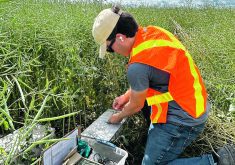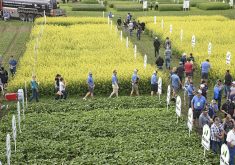If award-winning Crown Royal doesn’t put the words ‘fall rye’ back in your mouth, potential yields of 200 bushels per acre might do the trick
Crown Royal Northern Harvest Rye Whiskey from Seagram’s Gimli distillery grabbed Canada’s attention by winning the Jim Murray’s Whiskey Bible 2016 World Whisky of the Year Award.
The fact that Northern Harvest is distilled with 95 percent real rye no doubt drew the attention of some prairie farmers. After all, rye whiskey seems to be the preferred beverage of Canadian farmers.
Next time you’re enjoying a straight shot of the award winning stuff, consider that nearly all Seagram’s rye grain is purchased locally. Bucking the overwhelming corn trend, Seagram’s and its competition, Alberta Distillers, are holdouts who still distill their premium whiskey with a high percentage of rye grain.
Read Also

Canada’s plant hardiness zones receive update
The latest update to Canada’s plant hardiness zones and plant hardiness maps was released this summer.
After a long search for quality water, Seagram’s built its flagship distillery in Gimli, Man., in the late 1960s. Local grain production was every bit as important as water.
Other stories in this WP Special Report:
Located between Lake Manitoba and Lake Winnipeg, the word drought doesn’t exist in the vocabulary of the Interlake region.
The region gets a lot of rain, guaranteeing a reliable grain supply. Plus, the flavour of the rye is perfect for whiskey, says Seagram’s production manager, Richard Sydney.
“You capture that flavour, concentrate it, put it into a bottle and you’ve got a winning brand. Access to Interlake rye is a bonus for us because it’s better quality and has better flavour content,” states Sydney.
“The flavour might be due to rainfall, soil, or climate. For certain, things like botany and stress help the taste. Plant stressors make the plant exhibit more flavour characteristics. Our supplier contracts with farmers right here in the Interlake and they select the most flavorful grain for us.”
When asked about the test to quantify the flavor of rye grain, Sydney replied, “That’s simple. We smell every load that comes in. I do some of the smell testing and my technicians also do the tests. It needs lots of flavor to meet our standards.”
He says the company currently buys only conventional open pollinated rye grain, but they have begun considering the new hybrid varieties.
Out at Alberta Distillers Ltd. (ADL) in Calgary, truck after truck of rye grain is delivered to waiting distillers. Production specialist Rick Murphy says the company’s top of the line product, Alberta Premium, is made with 100 percent rye grain.
“In fact, all of our whiskeys use a very high percentage of rye grain compared to what’s typical in the industry,” says Murphy, adding that ADL buys only prairie-grown conventional varieties right now, but they are looking at the new hybrids.
“We’ve had a few hybrid samples submitted by our suppliers for evaluation, but we haven’t dug into it enough yet to make a decision.
“The higher falling numbers (of hybrid rye) relate to the activities of alpha-amylase in the meal. From our point of view, more alpha-amylase activity is better. But it’s not a strict requirement of the grain. Protein, however, is something we pay a lot of attention to.”
Murphy explains that most of the starch has been removed from the grain by the end of the fermentation process. That starch is converted to alcohol. Everything else is considered to be leftovers.
“More protein on a weight basis in the grain means you produce less alcohol. For another thing, proteins can cause all kinds of process issues.”
Murphy says they run tests on incoming rye grain, in search of low protein loads. They also run analysis on density, starch, moisture, dockage and a few others. The most important factor in selecting grain for whiskey is flavour.
“Believe it or not, we also do a sniff test for flavour,” laughs Murphy.















